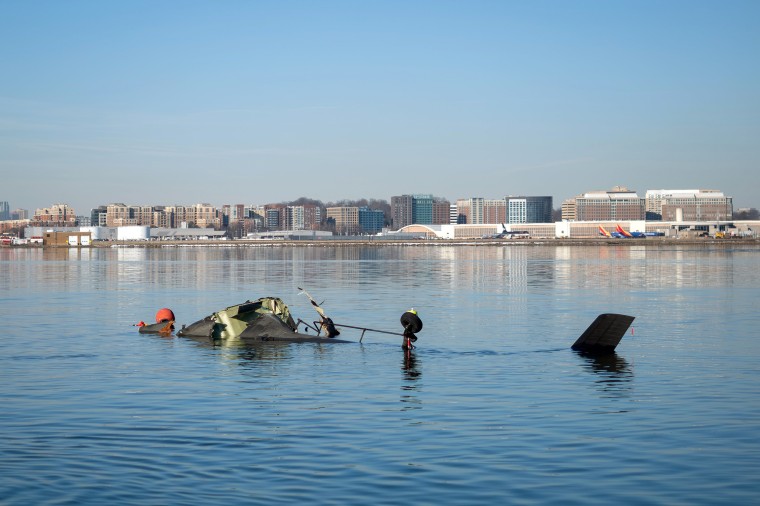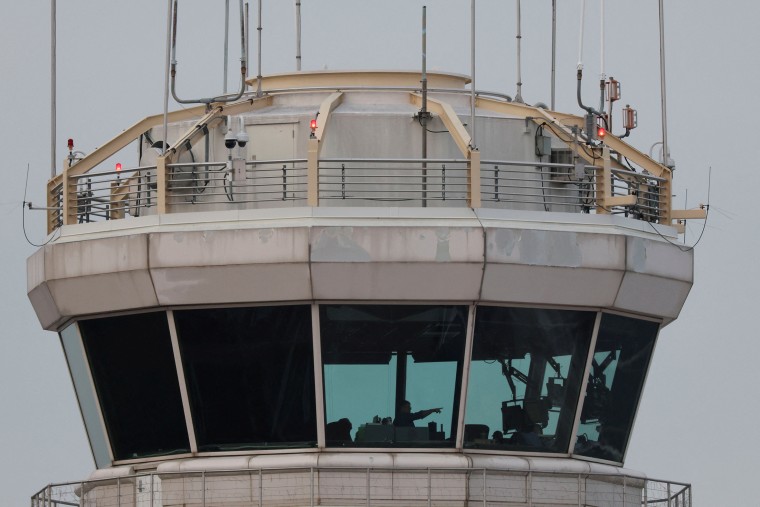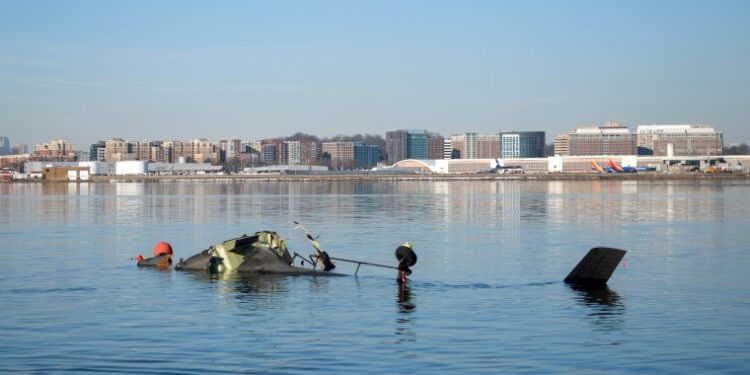The National Transportation Safety Board is looking into flight data discrepancies, potential altimeter malfunctions and a possible miscommunication with air traffic control in the midair collision of an Army helicopter and a commercial airplane last month in the deadliest U.S. air crash in almost a quarter century.
“We are looking at the possibility of there may be bad data,” NTSB chair Jennifer Homendy said at a news conference on Friday. “We have a lot of work to do till we get to that.”
The Jan. 29 collision near Washington, D.C., that killed everyone aboard the plane and in the helicopter, 67 people in all, has prompted fears of flying in the busy airspace above the nation’s capital, which transports roughly 25 million people each year.
The deadly accident has raised questions about whether helicopters — in particular military training flights — should be allowed to share such a narrow and busy airspace with commercial airplanes. It was the first major fatal commercial plane crash in the U.S. since 2009.

Video captured the moment the UH 60 Black Hawk crashed into American Eagle Flight 5342, the explosion lighting up the night sky as the aircraft plummeted into the Potomac River.
More than two dozen people connected to the sport of figure skating, including many young Olympic hopefuls, were on the American Eagle flight traveling from Wichita, Kansas. Among the three Army soldiers who died on the Black Hawk was a 28-year-old helicopter repairer who leaves behind an 18-month-old son.
Homendy said Friday the pilot flying the helicopter was on a “combined annual and night vision goggle check ride.” Check rides are generally an exam pilots must pass to perform specific aircrew or mission duties.
Investigators believe the crew was wearing night vision goggles throughout the flight, she said. Homendy noted that if the goggles had been removed, the crew was required to have a discussion about going unaided.
“There is no evidence on the cockpit voice recorder (CVR) of such a discussion,” she said at the news conference.
Homendy noted that there has been some discrepancy in the altitude of the helicopter. At 8:43 p.m. ET, the pilot flying indicated they were at about 300 feet, but an instructor pilot indicated they were at about 400 feet.
“Neither pilot made a comment discussing an altitude discrepancy,” she said. “At this time, we don’t know why there was a discrepancy between the two. That’s something the investigative team is analyzing.”
The helicopter also may not have received crucial information from air traffic control before the collision, she said.
At 8:46 p.m. a radio transmission from the tower was heard on the plane’s cockpit voice recorder informing the helicopter that a plane at 1,200 feet was circling just south of the Woodrow Wilson Memorial Bridge.
But cockpit voice recorder data from the helicopter indicates that the portion of the transition about the plane “may not have been received by the Black Hawk crew,” Homendy said.
She said the words “circling” could be heard on air traffic control communications but not on the helicopter’s cockpit voice recorder. The agency is investigating how that happened.
The American Eagle plane was descending to land around 9 p.m. when the military chopper was shifting from one flight path to another, a common move often performed in the airspace.
Seconds before the crash, the air traffic control tower had asked the Black Hawk whether it had the airplane in sight and advised it to directly pass behind the jet, audio from the tower shows.
Homendy said based on the helicopter’s cockpit voice recorder data “a portion of the transmission that stated ‘pass behind the’ may not have been received by the Black Hawk crew.”
“Transmission was stepped on by a point eight-second mic key from the Black Hawk,” Homendy said, noting that the chopper’s crew was trying to communicate with air traffic control at that time.
An air traffic control supervisor in the tower at Reagan National had let a controller end their shift early, a source familiar with the investigation confirmed to NBC News. That left one controller to handle both plane and helicopter traffic in the area, which is allowed under FAA regulations but not typical for that time of day at Reagan.
Officials say the Black Hawk was equipped with an advanced surveillance technology that helps the aircraft share more accurate data with air traffic controllers, known as an Automatic Dependent Surveillance-Broadcast, or ADS–B. Homendy said they could not say whether it was turned off.
“A lot of people are asking about was it turned off, there are other things we have to rule out first,” she said.
The three Black Hawk crew members were experienced Army aviators from Fort Belvoir, Virginia, who were conducting a training flight, said Jonathan Koziol, a senior Army aviation adviser who’s helping with the investigation.
Capt. Rebecca Lobach, the flight’s co-pilot, was undergoing the night portion of an annual evaluation to test a pilot’s knowledge and proficiency in the cockpit, Koziol said. Lobach’s unit in particular also has to be able to transport senior government officials out of the area without an instructor in the event of an emergency, Koziol added.
Lobach, an aviation officer since 2019, had about 500 flying hours, which Koziol said was “right on target.” Chief Warrant Officer 2 Andrew Loyd Eaves had double the amount, Koziol said.
The Black Hawk crew members were also believed to be wearing night-vision goggles, Homendy said, meaning their field of view may have been restricted.
“We’re going to have to see what was possible for them to see at the time leading up to the collision and the accident sequence,” she said.
Night-vision goggles can help pilots navigate dark terrain and obstacles, but it is like “looking through soda straws,” said Dean Winslow, a retired Air Force colonel and onboard physician, who is not involved in the investigation.
Koziol said the pilots likely would not have needed to wear goggles while flying through well-lit areas by the airport, but that they likely would have needed to wear them while flying over the water.
Aviation experts say accidents are rarely caused by a single issue.
“You have to have a chain of events that leads to this,” said Joe Nadock, who was an air traffic controller at Reagan National airport for about a dozen years.
Nadock, who worked at Reagan from 1988 to 2000, said he and other air traffic controllers understood that the runway for helicopters and planes was narrow, but he did not recall hearing concerns or complaints about the path’s configuration. “We knew it was close, but you knew you had to do your job,” he said.
Air traffic controllers have to act as soon as they see helicopters go above an altitude of 200 ft., which did sometimes happen, he said. “You tell them to verify your altitude,” Nadock said. “You tell them you’re at the wrong altitude. Descend now.”

Since the crash, the FAA said it has restricted helicopter traffic near Reagan National Airport until it can review the findings of the NTSB investigation. The FAA also said it has started reviewing other airports with high volumes of mixed helicopter and airplane traffic nearby, but insisted “air travel is the safest mode of transportation.”
Transportation Secretary Sean Duffy said the FAA needed to “surge” more air traffic controllers “into the system” and had a plan to do so. He also said officials have to “remake our airspace,” including upgrading outdated technology.
Meanwhile, after lawmakers raised concern about the appropriateness of conducting military training missions near a busy airport, Daniel Driscoll, President Donald Trump’s nominee to lead the Army, said he planned to review the protocols.
The crash came on the heels of the Army’s highest number of serious aviation accidents, including fatalities, in a decade.







